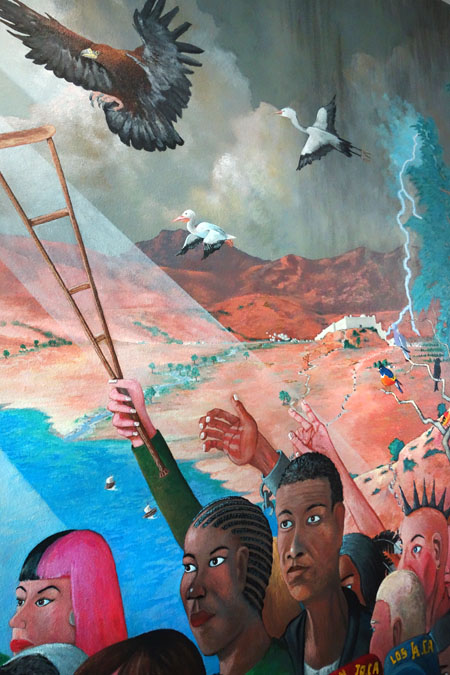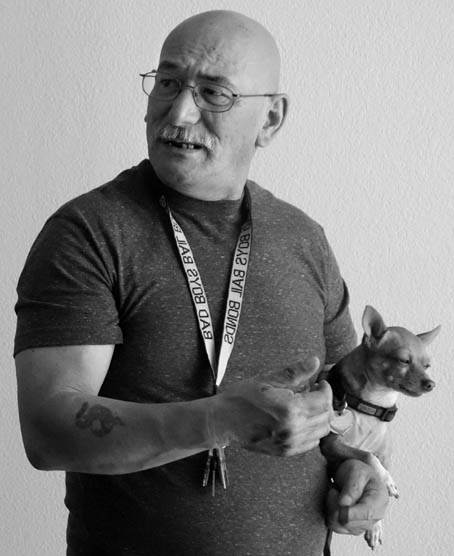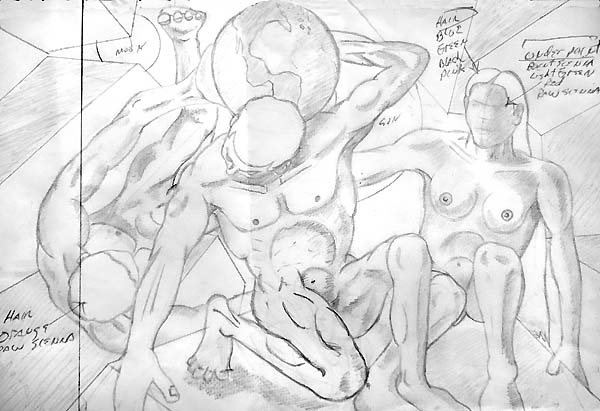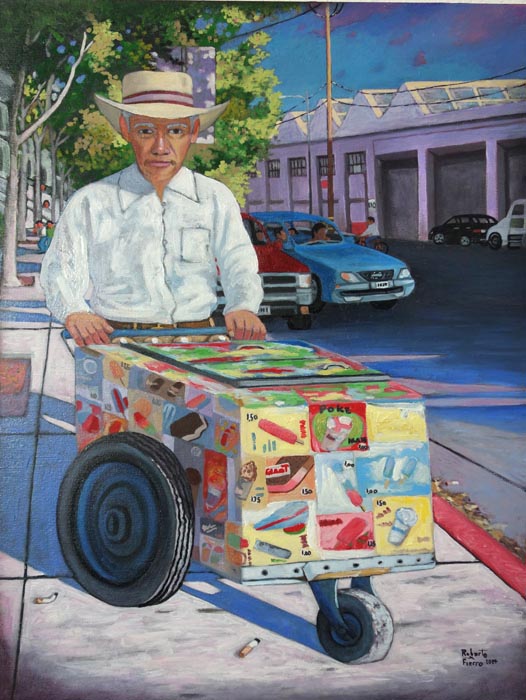Interviewsand Articles
Roberto Fierro : A Born Artist
by Richard Whittaker, Jan 5, 2015

Self portrait, Robert Fierro
San Jose artist, Tony May called just at the right time. “There’s an artist down here I think you’d find interesting. His name is Roberto Fierro. I bought a small painting from him.”
Tony is professor emeritus at San Jose State, where he taught for decades, and I pay attention to his recommendations. I asked him to tell me a little about the artist.
“He lives in a building called the Art Ark. It’s only a couple of blocks from where I live. It’s some kind of subsidized housing that’s meant for artists. I thought he worked small, but when I visited him I discovered these large murals in the hallways of this building.”
“He painted them?”
“Right, four of them. And it’s kind of odd, because they’re in these narrow hallways on the fourth floor. You can’t back up, you know, to get an overall look.”
“What would you say the dimensions are?”
“Maybe around twelve feet by twenty feet.”
Already, I liked the sound of it.

Real Life Adventures
I hadn’t visited Tony in quite a while, so this would be a double treat. Besides, I was wondering how I was going to complete the new issue and maybe this was the answer. Or not. There was that possibility, too.
Two days later, I was in San Jose. As Tony and I walked toward Fierro’s place he said, with a tiny hint of nervousness, “Remember, I really don’t know this guy.”
Roberto met us at the main entrance of the Art Ark with a Chihuahua tucked under his arm.
Earlier, I’d asked Tony, “How old is he, more or less?” Tony had guessed he was maybe fifty-three and, looking at Fierro, with his shaved head and fit appearance, I could have guessed about the same. So it was a mild surprise when, later in our conversation, he told us he was sixty-four.
“My place is on the top floor,” he said, and we all got in the elevator. “I could have had an apartment on the ground floor, but it’s quieter up on the fourth floor.”
Getting off the elevator, it was a short walk to the first mural. And gosh, there it was, exhibiting all the drama I would expect of a Mexican mural. The three of us stood there looking at this first mural and, while Tony asked Roberto one question after another, I pulled my camera out and began taking photos. Damn, I wished I had my 18mm lens from my old Nikon F3, but I let that go quickly. Why complain when one’s being served a visual feast?
We moved along the hallways from one mural to another, stopping at each one for a good spell. For most of that time, I occupied myself with my camera while trying to keep an ear open to the conversation between Tony and Roberto. At a certain point, as I was studying one of the murals, the artist’s ingenious use of multiple perspectives suddenly came home to me. And I remember Tony asking Fierro, “Did you study any of the classic Mexican muralists?” Fierro’s answer to that was, “No.” And I can understand why Tony might have wondered about that. It’s a little amazing to learn that Fierro is self-taught.
Fierro is a genial man, at ease in conversation and, at the same time, measured. At one point, he volunteered that he loves going downtown and just hanging out talking with people. It struck me that here is a man who knows how to stay present with another person. As we were unhurriedly getting to know one another, I realized I was truly enjoying the whole thing. And I knew I wanted to have Fierro’s work in the new issue.
After we finished looking at the murals, Fierro invited us into his little studio apartment. An unfinished canvas sat on his easel and four or five small paintings hung on the walls. “Where do you store your work?” Tony asked him. Fierro opened a closet door where several more paintings were stored in a compact arrangement.

[sketch for mural]
Journey
A few days after our visit, I called Fierro. I wanted to know, for instance, how had he gotten started as an artist. “Well,” he said, “I won an art contest when I was in 4th grade.”
I’m never surprised by such a story. It seems that early moments of that kind shape the lives of many people. In the earlier conversation with Tony, Roberto had mentioned that he’d been a field worker. His family had picked fruit and vegetables in various parts of California. And I wanted to know a little more about that.
"I come from a large family. There were nine kids, plus an adopted kid,” he told me. I asked him if it had felt like a hard life. “No. You know, as a kid you just go along. On Sundays, all the field workers would get together and there would be singing. All of us kids would play together. It was a real community. Everyone looked out for each other.”
But sometimes it was really hot, he told me. “I remember picking cotton near Bakersfield. They use these long bags to put the cotton in, and we’d get paid by weight. My mother made me a smaller bag and when I’d filled it up with cotton, I’d take it to the scales. They would pay you right there. So I’d take my money and go buy myself something cold like a soda and I’d sit in the shade of one of the only trees around. I’d just sit there and take my time.” It was, I gathered, a pleasure most of us unfamiliar with such an elemental transition could hardly understand.
He’d been working in the fields from childhood and that continued, even in high school, he told me. And when he graduated, he went to trade school and became a machinist.
When Fierro showed us the paintings stored in his closet, I noticed one in particular, a self-portrait. I asked if he’d bring it out and let me photograph it. Mostly, he worked in acrylics, he told me, but the self-portrait was done in pigmented ink. When I looked at the painting more carefully, I noticed there was a prison. “Did you ever spend time in prison?” I asked. “No. I put that in there because of one of my uncles. I visited him in prison. But life can be a prison, too,” he said.
I asked Fierro what he meant by that.
“Well, sometimes you can’t do what you want to do. I spent so many years being a machinist, but I wanted to be painting. I did paint in my spare time, but I had to earn a living. and it felt like a prison.”
I nodded my head.
“At the bottom of that painting I put in some strawberries. We picked strawberries and onions by Moffett Field. My dad liked it here in the Santa Clara Valley and we got a little house near Milpitas. In those days, it was just a rural area.”
“What’s it like now that you can paint all the time?” I asked him.
“It’s great. I waited all these years. My sister asked me, “Why don’t you have a TV?” I told her, “I don’t need a TV.” Then he told me, “When I get a little money, I go and buy more paint and canvas. Why would I spend it on anything else?” 
About the Author
Richard Whittaker is the founding editor of works & conversations and West Coast editor of Parabola magazine
SUBSCRIBE NOW
TO OUR MONTHLY NEWSLETTER









Share Your Comments and Reflections on this Conversation:
On Aug 13, 2015 Judy Kahn wrote:
What I liked most about Roberto when we visited his amazing hallway gallery was the way he held his little chihuahua. Such a big, muscular guy, but so tender with that tiny creature. You really have an eye, Richard, for finding great artists with deep spirits.On Jan 12, 2015 Arny Garza wrote:
I believe I was in Bobby's class at Joseph Weller elementary in fourth grade mrs. Marshman....he used crushed glass from perhaps aspirin bottles and laid it out to create a palm beach island scenario....blew me away...On Jan 11, 2015 Frances Flanagan wrote:
My Uncle always had this amazing talent to paint, growing up he painted on my Grandma's living room wall, I believe he was a teen. I would be awesome if the painting could be display in an Art Gallery in Denver, ColoradoBlessing to my Uncle Bobby
On Jan 11, 2015 Edward Rivas, AZ USA wrote:
I'm Glad to see some appreciation for Bob Ferrio's art work. I've known Bob my whole life and his parents. I was his neighbor in Milpitas, CA. For many years. His art work should be in galleries across the valley. You've discovered a well known talent in Bob, keep your eyes on him. He'll come up with some of the best art work you've ever seen. -Great job Bob!On Jan 11, 2015 Iron Lion wrote:
SOLID SOUL!!!!On Jan 11, 2015 Leopoldo Fierro Jr. wrote:
I have always conspired to compel my Uncle B to go public with his work...he always told me he painted for his family not money. As shallow as that may appear in words...it is a fact that inspired my art literature..we inspire motivate others and pprojecting our individuality..yet remaining Interpendent to our source. IM close to my uncle B like bark to a tree and as much as we leave..from root to fruit we are six soul!!! Thanks uncle B for coming thru and guiding me good..may your colors never dry up!-Iron LionOn Jan 11, 2015 Jeannie allen wrote:
I Love the man that you interviewed he is my cousin Bobby, his dad and mom took in my dad Federico Sosa Fierro in when he lost my grandparent as a small child. Bobby dad and my dad dad were brothers. I love him and am so proud of him. We came from a family full of love and faith.On Jan 11, 2015 Jeanette Rivas wrote:
I think this article was fantastic I have know Roberto since I was 8 Years old and have seen a lot of his work I am so proud of him.